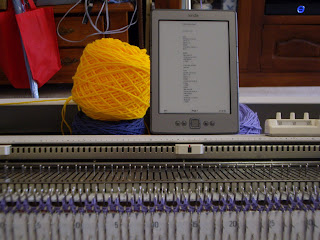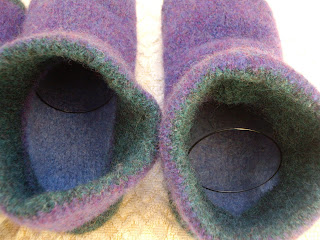
I decided to make a vest in July, to wear to the Bendigo Show. A plain simple vest. Right. Finished it this week.
I'm still learning how to use the mid gauge and decided to do the cast on for the 2:2 IR rib in the book. I tried many times before realising that I was doing it right - but it looked awful because it was awful. I tried to adapt the Passap cast on.. nope didn't work either. In the end I used the Knitted back e wrap cast on (Ch2.5 in Susan Guagliumi's HMS4MKers) that works so well for single bed Passap work. I put three extra to move back a needle to keep it even: I started out with 7 sts, used the double eyelet to transfer 2 sts to the ribber, moved 3 over one needle, cast on 4 more and so on until I had it all done. While it worked I'm still looking for a "perfect" cast on for 2:2 IR on the middi, going to do a crochet cast on next.
I had 3 x 200G Bendigo Woollen Mills 8ply Bramble Allegro
and 1 x 200G BMW 8ply Dark Plum 8ply Classic
Now onto the back:
Cast on 2:2 IR, 65L to 65R, T2.2 both beds; knit 20 rows.
On the ribber: leave the 10 centre ones, and transfer all the others into the single needle space on the main bed.
T5 MB and T2.2 Ribber. RC000, knit 120 rows
Armhole: RC 000
-10 next two rows
-1 ev 2rows 9 times
straight to 72 RC
Shape Shoulder:
-8 next 4 rows. (I did short rows, then one more to seal it off)
take off however you like, I put onto circ needles.
Fronts:
Cast on 47 (counting on the main bed, the ribber stitches count as one.
T2.2, knit 20 rows.
transfer all stitches to main bed but keep the ribber up and use the ribber arm
- otherwise... you guessed it... you make it and the tension is different.. so you have to make it again to match the back - and that was just ONE of the many, many undos I did, just warning ya!
T5, ribber up but no stitches, knit 120 rows. RC000
-10
-1 ev alt row 9 times
straight to 72
-8 (Armhole edge) ev 2nd row twice.
make another one with reverse shaping.
Now wasn't that easy? I thought so.
Band
This is where I really, really came unstuck. I didn't buy enough wool and I couldn't for the life of me work out where to get a magic ball (for the non Aussies, one of our famous painters, Norman Lindsay, wrote and illustrated a book called the
Magic Pudding, about a pudding that never ran out. A classic children's book here).

Now back to the band... for reasons known to noone I wanted a wide band. And have enough left over for a small sleeve cap.. I really liked the Kaino vest and had this in mind.
Things I tried that didn't work: Do it on the passap with the two colour changer with two rows each of dark plum and bramble. Ran out of wool. Made it thinner, only 5o rows to go.. Ran out of wool. Remade it on the Passap with 6 rows of dark plum across the back of the neck - nope still ran out. Went back to the vest. Did it really have to be that long? OK I could do with 30 rows less. Undid everything. Remade it all with 120 rows.... sigh... Will this vest ever get made?
Back to the band:
Let's pretend I bought enough to do the whole thing in one colour:
Cast on ... heavens I didn't write down the numbers properly, but
11 groups of 2 on the main bed and 10 on the ribber would be good. Take a look on your back and decide if you want it that wide or wider. anyway, here's the numbers:
T2.2
Knit to 140 rows, RC000
+ 1 st every 4 rows (however you like) 18 times (RC64),
knit straight to RC 76 PUT IN A MARKER on the neck edge (where the increases are). RC000
straight to 74 RC. PUT IN A MARKER on the neck edge. RCOOO
knit straight to 12RC
- 1 st every 4 rows (however you like, but looks good if you match the increases). RC76. Reset RC000
work straight to 170 rows.
Of course... I couldn't do that, could I?
so ... one of the Ravelry girls did and excellent job making socks on her single bed, I was very impressed with the clean line she got on the join. After "freeing up" the wool from 3o rows front and back. I felt I was onto something.
So... I made an outer Dark Plum strip, with about 10 rows too many in case I mucked up the maths, with a 7:7 count on the 2:2 rib, but put 3 on each end. one for the roll on the font edge and one on the other side for the join (I did a practice piece to work this out too... I did say this vest took six weeks to make, didn't I?)
then made a shaped strip 7:7 wide, again with the 3 sts (on the main bed) on the edge. Now there isn't a lot of room, so I ran a contrast thread for about 30 or so times (60 rows) so I could pick up that bar on the edge easily. The bar is slipped over the last needle every second row, which was easy to see which one while the cast on bar was in the way, I didn't worry about picking up the cast on row, I started with the first bar and pulled out the marking thread as I went. Yes it did take a bit more time, but I did it all in an afternoon and would certainly use this method again, I thought it was an excellent backup for adding a vertical stripe.
Now onto the Sleeve Cap:
join your shoulder seam however you like. I do the 3 needle cast/bind off.
Then I picked up every row, not the 3 of 4 that is usually done, with the Dark Plum and knitted in the pick up row on 3.25 circs (168 sts), then hung them in 2:2.
Start the short rows immediately. (yep, I did they twice to figure this out too). SET both carriages to short row.
(BUT IF I MADE THIS AGAIN I'd start in the middle and work my way outwards).
Easiest way to explain is - do you counting on the ribber:
on the left side, pull the needles up to the 7th group of 2.
knit 1 row, hang a claw weight,
pull up the NEXT needle on the main bed and pull up the same number on the opposite side,
knit 1 row, hang claw weight,
pull up the NEXT needle on the main bed and pull up 3 on the opposite side,
knit 1 row, continue, pulling up 1 on the carriage side and 3 on the opposite until 11 (eleven) groups of 11 (two) have been short rows (row 18)
ROW 19:
watch what you are doing: slowly start to knit, and when you see the LEFT HAND edge of the carriages clear the stitches on hold and are on the bit that hasn't been short rowed, THEN on the LEFT HAND SIDE flip your russell levers to pick up the short rows. BUT if you don't watch what's happening, you can miss collecting them (yep just one of the many redos on this vest).
ROW 20: flip the russell levers on the right side and knit all stitches.
work straight to RC24, change colour to main and knit 6 more rows.
Cast off however you prefer.
Do the other one.
Things I'd do differently on the next one:

buy enough wool.
the front band thinner - make it the same width as the back
on the shoulder do -5, -5 -5 and add two more rows each side on the bands.
Start the short rows on the sleeve caps in the middle, that would be better.
That's it.
My Neverending Big Vest.





























































